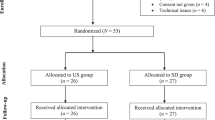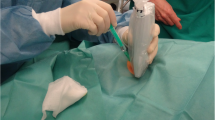Abstract
Critically ill newborns admitted to Neonatal Intensive Care Unit often require a centrally inserted central catheters (CICCs) inserted by ultrasound-guided puncture of the internal jugular or brachio-cephalic vein. Achieving an appropriate level of sedation and analgesia is paramount for procedure success and patient safety, avoiding the potential risks associated with excessive deep sedation. The aim of this study is to evaluate the feasibility of a novel protocol of sedation. Data from 46 patients were prospectively collected. The feasibility was assessed throughout the monitoring of adverse events and the incidence of spontaneous movements. The procedure was completed in 100% of cases. There were no cases of escalation of the baseline ventilatory support despite the procedure and no case of hypotension, and all spontaneous movements were controlled with additional boluses when required.
Conclusion: Our study represents the very first step towards the design of a validated protocol for analgosedation during ultrasound-guided CICC insertion in NICU.
What is Known: • Critically ill newborns admitted to Neonatal Intensive Care Unit often require a centrally inserted central catheter. • Achieving an appropriate level of sedation and analgesia is paramount for procedure success and patient safety, avoiding the potential risks associated with excessive deep sedation. | |
What is New: • The use of this new protocol for analgosedation is able to achieve a good level of sedation and pain control without significant adverse event. • Ultrasound-guided CICC insertion can be performed even in non-ventilated newborns. |


Similar content being viewed by others
Data availability
No datasets were generated or analysed during the current study.
Abbreviations
- AE:
-
Adverse events
- CICC:
-
Centrally inserted central catheters
- NICU:
-
Neonatal Intensive Care Unit
- UVC:
-
Umbilical venous catheter
References
D’Andrea V, Prontera G, Rubortone SA, Pezza L, Pinna G, Barone G, Pittiruti M, Vento G (2021) Umbilical venous catheter update: a narrative review including ultrasound and training. Front Pediatr 9:774705
Gorski LA, Hadaway L, Hagle ME, Broadhurst D, Clare S, Kleidon T, Meyer BM, Nickel B, Rowley S, Sharpe E, Alexander M (2021) Infusion therapy standards of practice, 8th Edition. J Infus Nurs 44:S1–S224
Hoellering A, Tshamala D, Davies MW (2018) Study of movement of umbilical venous catheters over time. J Paediatr Child Health 54:1329–1335
Barone G, Pittiruti M (2020) Epicutaneo-caval catheters in neonates: new insights and new suggestions from the recent literature. J Vasc Access 21:805–809
Barone G, Pittiruti M, Ancora G, Vento G, Tota F, D’Andrea V (2021) Centrally inserted central catheters in preterm neonates with weight below 1500 g by ultrasound-guided access to the brachio-cephalic vein. J Vasc Access 22:344–352
Rhondali O, Attof R, Combet S, Chassard D, de Queiroz SM (2011) Ultrasound-guided subclavian vein cannulation in infants: supraclavicular approach. Paediatr Anaesth 21:1136–1141
Guilbert AS, Xavier L, Ammouche C, Desprez P, Astruc D, Diemunsch P, Bientz J (2013) Supraclavicular ultrasound-guided catheterization of the subclavian vein in pediatric and neonatal ICUs: a feasibility study. Pediatr Crit Care Med 14:351–355
Lausten-Thomsen U, Merchaoui Z, Dubois C, Eleni Dit Trolli S, Le Sache N, Mokhtari M, Tissieres P (2017) Ultrasound-guided subclavian vein cannulation in low birth weight neonates. Pediatr Crit Care Med 18:172–175
Merchaoui Z, Lausten-Thomsen U, Pierre F, Ben Laiba M, Le Sache N, Tissieres P (2017) Supraclavicular approach to ultrasound-guided brachiocephalic vein cannulation in children and neonates. Front Pediatr 5:211
Lamperti M, Bodenham AR, Pittiruti M, Blaivas M, Augoustides JG, Elbarbary M, Pirotte T, Karakitsos D, Ledonne J, Doniger S, Scoppettuolo G, Feller-Kopman D, Schummer W, Biffi R, Desruennes E, Melniker LA, Verghese ST (2012) International evidence-based recommendations on ultrasound-guided vascular access. Intensive Care Med 38:1105–1117
Breschan C, Graf G, Arneitz C, Stettner H, Feigl G, Neuwersch S, Stadik C, Koestenberger M, Holasek S, Likar R (2020) Feasibility of the ultrasound-guided supraclavicular cannulation of the brachiocephalic vein in very small weight infants: a case series. Paediatr Anaesth 30:928–933
Breschan C, Graf G, Arneitz C, Stettner H, Neuwersch S, Stadik C, Koestenberger M, Holasek S, Likar R (2022) Retrospective evaluation of 599 brachiocephalic vein cannulations in neonates and preterm infants. Br J Anaesth 129:e138–e140
Breschan C, Graf G, Jost R, Stettner H, Feigl G, Goessler A, Neuwersch S, Koestenberger M, Likar R (2015) Ultrasound-guided supraclavicular cannulation of the right brachiocephalic vein in small infants: a consecutive, prospective case series. Paediatr Anaesth 25:943–949
Breschan C, Platzer M, Jost R, Stettner H, Beyer AS, Feigl G, Likar R (2011) Consecutive, prospective case series of a new method for ultrasound-guided supraclavicular approach to the brachiocephalic vein in children. Br J Anaesth 106:732–737
Breschan C, Platzer M, Jost R, Stettner H, Feigl G, Likar R (2012) Ultrasound-guided supraclavicular cannulation of the brachiocephalic vein in infants: a retrospective analysis of a case series. Paediatr Anaesth 22:1062–1067
Ostroff M, Zauk A, Chowdhury S, Moureau N, Mobley C (2021) A retrospective analysis of the clinical effectiveness of subcutaneously tunneled femoral vein cannulations at the bedside: a low risk central venous access approach in the neonatal intensive care unit. J Vasc Access 22:926–934
Barone G, D’Andrea V, Ancora G, Cresi F, Maggio L, Capasso A, Mastroianni R, Pozzi N, Rodriguez-Perez C, Romitti MG, Tota F, Spagnuolo F, Raimondi F, Pittiruti M (2023) The neonatal DAV-expert algorithm: a GAVeCeLT/GAVePed consensus for the choice of the most appropriate venous access in newborns. Eur J Pediatr 182(8):3385–3395
Lago P, Garetti E, Boccuzzo G, Merazzi D, Pirelli A, Pieragostini L, Piga S, Cuttini M, Ancora G (2013) Procedural pain in neonates: the state of the art in the implementation of national guidelines in Italy. Paediatr Anaesth 23:407–414
Lago P, Garetti E, Merazzi D, Pieragostini L, Ancora G, Pirelli A, Bellieni CV, Pain Study Group of the Italian Society of N (2009) Guidelines for procedural pain in the newborn. Acta Paediatr 98:932–939
Lago P, Tiozzo C, Boccuzzo G, Allegro A, Zacchello F (2008) Remifentanil for percutaneous intravenous central catheter placement in preterm infant: a randomized controlled trial. Paediatr Anaesth 18:736–744
Pittiruti M, Celentano D, Barone G, D’Andrea V, Annetta MG, Conti G (2022) A GAVeCeLT bundle for central venous catheterization in neonates and children: a prospective clinical study on 729 cases. J Vasc Access 24(6):1477–1488
Brescia F, Pittiruti M, Ostroff M, Spencer TR, Dawson RB (2023) The SIC protocol: a seven-step strategy to minimize complications potentially related to the insertion of centrally inserted central catheters. J Vasc Access 24:185–190
Brescia F, Pittiruti M, Ostroff M, Spencer TR, Dawson RB (2021) The SIF protocol: a seven-step strategy to minimize complications potentially related to the insertion of femorally inserted central catheters. J Vasc Access 24(4):527–534
D’Andrea V, Barone G, Pezza L, Prontera G, Vento G, Pittiruti M (2022) Securement of central venous catheters by subcutaneously anchored suturless devices in neonates. J Matern Fetal Neonatal Med 35:6747–6750
D’Andrea V, Pezza L, Prontera G, Ancora G, Pittiruti M, Vento G, Barone G (2022) The intracavitary ECG method for tip location of ultrasound-guided centrally inserted central catheter in neonates. J Vasc Access 24(5):1134–1139
Lamberti G, Domenichelli V, Straziuso S, Pelusi G, Natile M, Ancora G, Barone G (2023) Use of the dialkylcarbamoylchloride dressing in the care of central venous access exit site in a pediatric and neonatal population. Diagnostics (Basel) 13(9):1520
Taddio A, Lee C, Yip A, Parvez B, McNamara PJ, Shah V (2006) Intravenous morphine and topical tetracaine for treatment of pain in [corrected] neonates undergoing central line placement. JAMA 295:793–800
Anand KJ, International Evidence-Based Group for Neonatal P (2001) Consensus statement for the prevention and management of pain in the newborn. Arch Pediatr Adolesc Med 155:173–180
D’Andrea V, Prontera G, Barone G, Vento G (2023) Combination of ketamine and fentanyl (KetaFent) for safe insertion of ultrasound-guided central venous catheters in infants. Front Pediatr 11:1033793
Anand KJ, Scalzo FM (2000) Can adverse neonatal experiences alter brain development and subsequent behavior? Biol Neonate 77:69–82
Muller M, Bryant KA, Espinosa C, Jones JA, Quach C, Rindels JR, Stewart DL, Zangwill KM, Sanchez PJ (2023) SHEA Neonatal Intensive Care Unit (NICU) White Paper Series: Practical approaches for the prevention of central-line-associated bloodstream infections. Infect Control Hosp Epidemiol 44:550–564
Funding
The authors declare that no funds, grants, or other support were received for the study.
Author information
Authors and Affiliations
Contributions
Dr GB had responsibility for protocol development, patient screening, enrollment, outcome assessment, preliminary data analysis, and writing the manuscript. Drs MN, VD, and CSN participated in the development of the protocol and analytical framework for the study and contributed to the writing of the manuscript. Dr GA conceived the analgosedation protocol and the study itself, supervised the design and execution of the study, performed the final data analyses, and significantly contributed to the writing of the manuscript. All authors read and approved the final manuscript.
Corresponding author
Ethics declarations
Ethical approval
The study was approved by our local Ethics Committee (CEROM), and the parents of each patient provided written informed consent. Number of approval was 2790.
Competing interests
The authors declare no competing interests.
Additional information
Communicated by Daniele De Luca
Publisher's Note
Springer Nature remains neutral with regard to jurisdictional claims in published maps and institutional affiliations.
Rights and permissions
Springer Nature or its licensor (e.g. a society or other partner) holds exclusive rights to this article under a publishing agreement with the author(s) or other rightsholder(s); author self-archiving of the accepted manuscript version of this article is solely governed by the terms of such publishing agreement and applicable law.
About this article
Cite this article
Barone, G., Natile, M., Nigro, C.S. et al. Prospective case series study on the use of a novel analgosedation protocol for ultrasound-guided catheterization in Neonatal Intensive Care Unit. Eur J Pediatr (2024). https://doi.org/10.1007/s00431-024-05557-9
Received:
Revised:
Accepted:
Published:
DOI: https://doi.org/10.1007/s00431-024-05557-9




